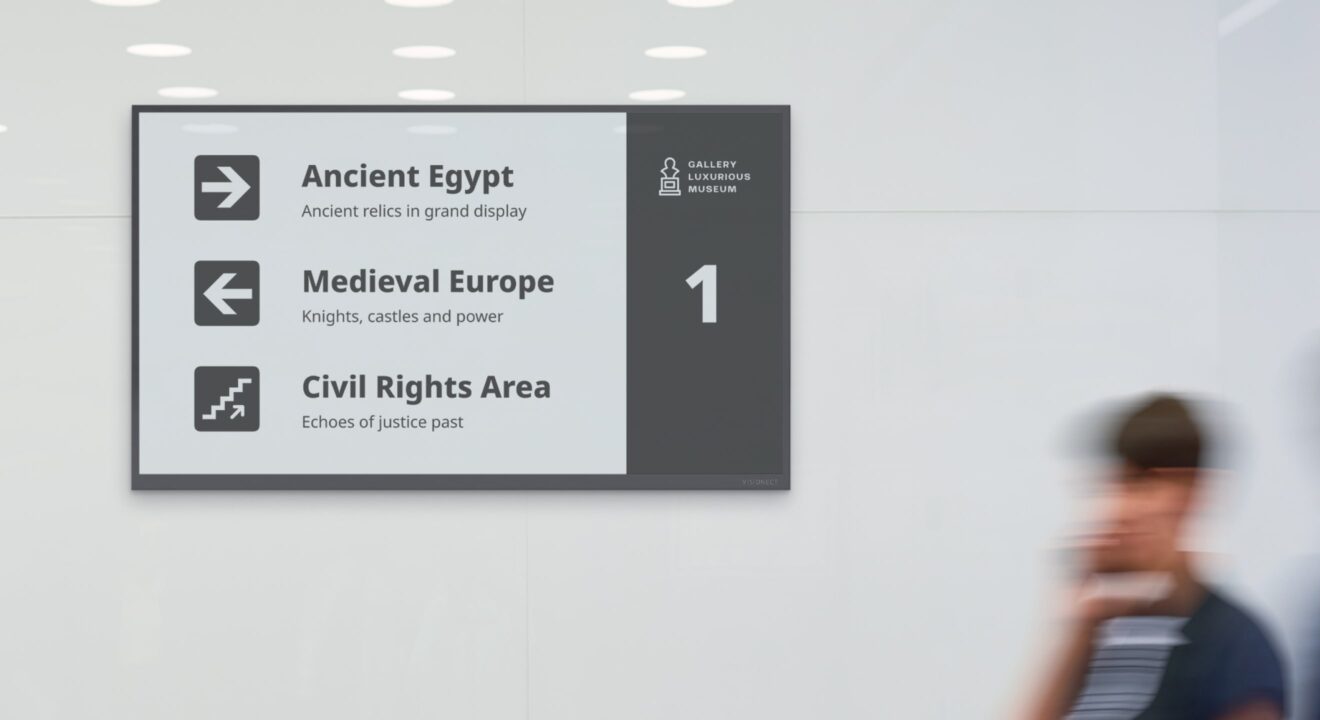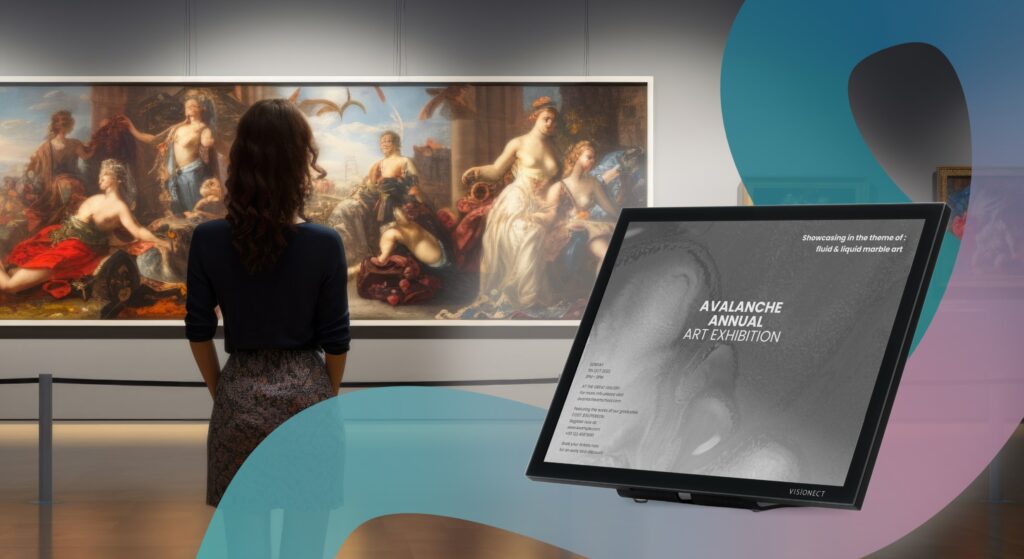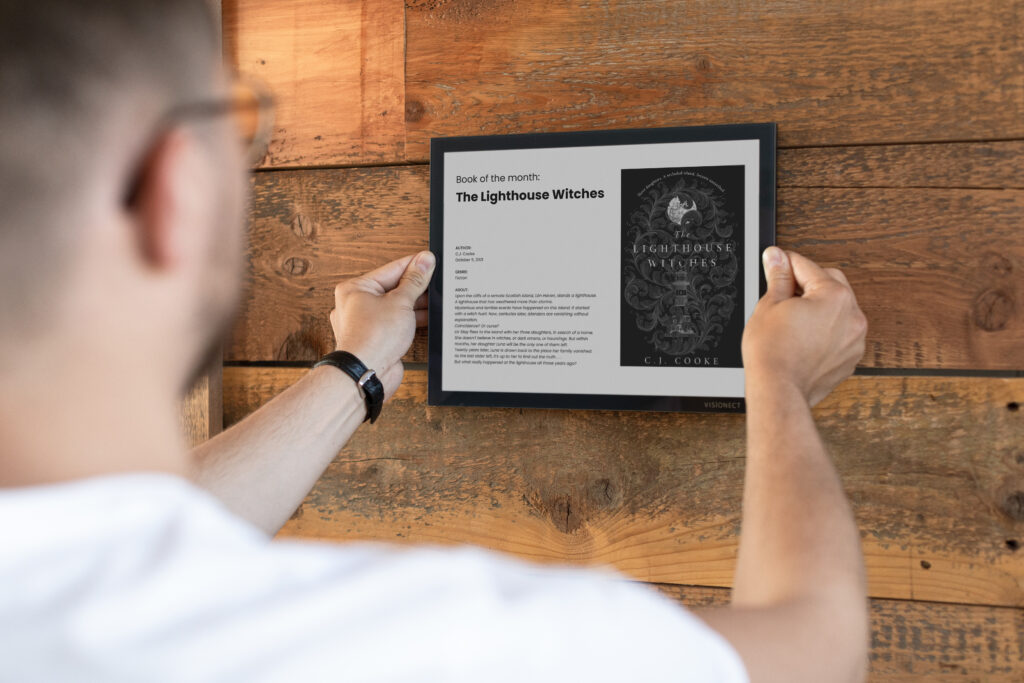

The Ultimate Guide to Digital Signage for Museums
Visionect, 26 Jun 2025
Museums are evolving to meet modern visitor expectations, and digital signage is playing a key role in that shift. These displays go beyond sharing information by guiding guests, enhancing exhibits, and creating interactive moments that bring collections to life.
In this guide, we’ll explore how museums can use digital signage to boost engagement, simplify operations, and create a more dynamic and visitor-friendly experience.
What are the benefits of digital signage for museums?
Digital signage offers museums a flexible, modern way to improve both the visitor experience and behind-the-scenes operations.
Key benefits include:
- Deliver real-time updates for events, exhibit changes, and visitor alerts
- Improve navigation with digital maps and wayfinding that adapt to your layout
- Support multilingual communication with digital content tailored to diverse audiences
- Create interactive experiences that support self-guided tours and learning tools
- Offer eco-friendly alternatives to printed signage that reduce paper use and waste
- Share rotating content such as artist bios, exhibit highlights, or curator insights
Together, these benefits make digital signage an essential tool for museums to engage visitors more effectively while improving operational efficiency.
Use cases: How are museums optimizing signage?
Recapping some key use cases from our earlier article, Digital Signage for Museums: Use Cases and Best Practices, here’s a quick look at how museums are putting digital signage to work:
- Entrance and lobby signage
- Wayfinding and navigation
- Exhibit enhancement
- Interactive experiences
- Events and programs promotion
- Social engagement screens
- Artist and donor recognition
- Membership and retail promotions

By using digital signage in all these ways, museums can make visits more engaging, easy to navigate, and memorable for everyone who walks through the door.
What is the best screen for museum signage?
Choosing the best screen for your museum’s digital signage depends on where and how you plan to use it. Here’s a quick look at three popular options—LED, LCD, and e-paper—with their pros, cons, and ideal uses.
LED & LCD signage
Pros:
- Bright, vibrant colors and sharp images
- Great for video content and dynamic visuals
- Ideal for attracting attention in busy or lively areas
Cons:
- Can produce glare or reflections in bright spaces
- Higher energy consumption
- Sometimes too visually intense for quiet, contemplative environments
- Require a regular power source and therefore cabling or installation
Best use cases:
- Large video walls, advertising, and interactive kiosks in active areas
E-paper signage for museums
Pros:
- Paper-like, non-glare appearance that blends into museum spaces
- Easily readable in any lighting, including bright sunlight
- Extremely energy efficient with some running months on one battery charge
- Wireless installation means no messy cables or complicated setups
- Quiet and subtle, preserving the calm museum atmosphere
Cons:
- Limited to HD greyscale images
- Not suited for fast-moving video content
Best use case:
- Exhibit labels, wayfinding signs, event updates, and any display where subtlety and sustainability matter
- Ideal for locations where cables or wiring aren’t feasible, offering clean, wireless installation
In short, if you want vibrant, attention-grabbing visuals, LED or LCD screens work well in high-traffic or event spaces.
But for seamless integration, energy savings, and a gentle visitor experience, e-paper is the top choice for museums looking to combine technology with atmosphere.
EXPLORE THE VISIONECT E-PAPER DISPLAY CATALOGUEWhat is the best CMS for digital signage for museums?
A Content Management System (CMS) is the backbone of any successful digital signage network. CMS platforms let you create, manage, and update content across multiple screens easily and efficiently.
For museums, a good CMS is essential to keep displays up-to-date, relevant, and engaging without the hassle of constant hands-on updates.

Key features to look for
When choosing a CMS for your museum’s digital signage, consider these essential features:
- Multi-location support. Manage content across multiple galleries or museum sites from a single platform.
- Real-time updates. Instantly push new announcements, event changes, or emergency alerts across your screens.
- Cloud-based management. Access and manage content remotely, ensuring flexibility and scalability for your signage network.
- Secure infrastructure. Built-in security protocols ensure safe and uninterrupted operation.
- Tailored for your displays. Get the most out of your graphics with a CMS that optimizes your digital signage solutions.
Choosing a CMS platform
Several popular CMS platforms offer user-friendly interfaces and strong integration options, making them solid choices for general digital signage needs:
- Easescreen. Flexible platform with customizable options for various business needs.
- ScreenCloud. Easy to use with strong central control and app integrations.
- NoviSign. Drag-and-drop editor designed for users without technical skills.
- Scala. Built for large, complex deployments but can be more complicated to manage.
- Rise Vision. Affordable and simple, popular with education and smaller organizations.
However, for museums prioritizing e-paper technology, choosing a CMS that’s specifically designed to optimize these displays while also supporting other screen types is crucial for a smooth and efficient digital signage experience.
A CMS for inspired spaces
The Place & Play CMS stands out by offering:
- Expert management of ultra-low-power e-paper displays
- Seamless compatibility with LCD and LED screens for hybrid networks
- One centralized platform for effortless, real-time content control across all displays
- Subtle, non-intrusive aesthetic options and designs
- Streamlined workflows that simplify content updates and scheduling
- Energy-efficient configurations that reduce maintenance and upkeep costs
This tailored approach makes the Place & Play CMS an ideal choice for museums looking to combine sustainability, flexibility, and ease of use.
Learn how to choose the best CMS for your e-paper project.
Steps for implementing digital signage for museums
A smooth digital signage rollout starts with careful planning and clear goals. Here’s a step-by-step process to guide your museum through deployment:
Step-by-step deployment process:
- Define your signage goals: What do you want to achieve? (e.g., wayfinding, engagement, promotions)
- Choose strategic locations and appropriate hardware based on visitor flow and space
- Select a CMS platform that fits your technology and content needs
- Design content templates that are clear, engaging, and easy to update
- Train staff to manage content and troubleshoot basic issues
- Monitor performance regularly and refine your strategy based on visitor feedback and data
Pitfalls to avoid:
- Overloading screens with too much information, which can overwhelm visitors
- Neglecting accessibility features like multilingual support and high-contrast visuals
- Placing screens in poor locations where they’re hard to see or cause traffic bottlenecks
By following these steps and avoiding common mistakes, your museum can create a digital signage experience that’s both effective and visitor-friendly.
How to create an effective content strategy for museum signage
Creating great content for museum digital signage is just as important as choosing the right screens. A well-planned content strategy ensures your messages are clear, engaging, and accessible to all visitors.

Here are key tips to get started:
- Tone and style. Keep language friendly, concise, and approachable. Match your museum’s brand voice while making content easy to understand for diverse audiences.
- Visual hierarchy and readability. Use clear headings, bullet points, and plenty of white space. Choose fonts and colors that are easy to read from a distance and maintain strong contrast.
- Multilingual and multicultural considerations. Offer content in multiple languages to serve a diverse pool of visitors. Be mindful of cultural sensitivities and imagery to create an inclusive experience.
- Seasonal and rotating content. Plan regular updates to highlight special exhibits, events, or holidays. Rotating content keeps signage fresh and encourages repeat visits.
- Templates and design examples. Use consistent templates for different types of content—like wayfinding, event promos, or exhibit info—to maintain a cohesive look. Simple, clean designs work best for content absorption.
By focusing on these areas, your museum can deliver digital signage content that educates, inspires, and welcomes every visitor.
Choosing sustainable signage solutions
Museums can reduce their environmental impact by choosing sustainable digital signage options. Here’s how:
- Use low-power technology like e-paper, which consumes minimal energy and can run for months on a single battery charge
- Reduce power consumption by setting devices to refresh less often and update content at longer intervals
- Select displays made from reusable, renewable, or recyclable materials such as aluminum or glass to minimize waste
- Opt for wireless installations to avoid unnecessary cabling and reduce material use.
- Extend device lifespan with durable hardware designed for easy maintenance and longevity
These steps help museums combine technology with sustainability while delivering engaging visitor experiences.
Next steps for your signage journey
Are you looking to steer your museum’s digital signage from idea to reality? These next steps will help you explore options, discover the right technology, and connect with experts who can guide your project smoothly.
- Explore real-world examples. See how museums like Leicester Museum and Art Gallery use digital signage to engage visitors and improve operations.
- Discover Visionect Place & Play. Learn about our digital signage solutions that combine low power technology with easy installation and elegant design.
- Contact our experts. Get in touch with our team to discuss your museum’s unique needs and find the best digital signage solution for you.
Whether you’re just starting to explore digital signage or looking to upgrade your current setup, our team is here to help you bring your vision to life with technology that’s sustainable, flexible, and suited to museum environments.
GET IN TOUCH TODAYTags

